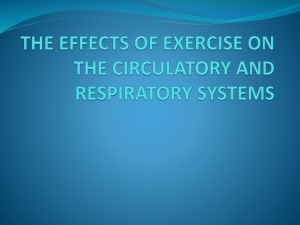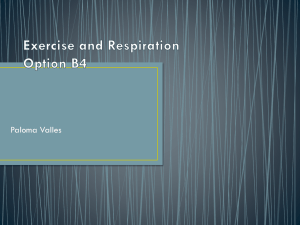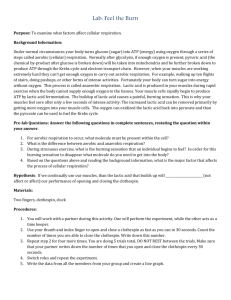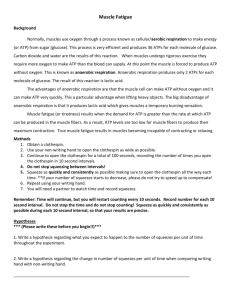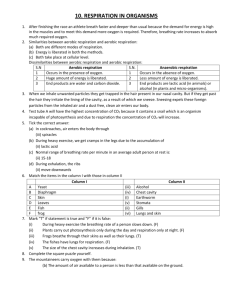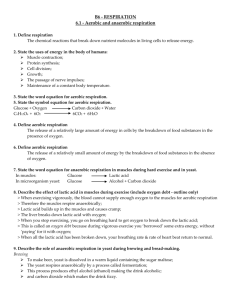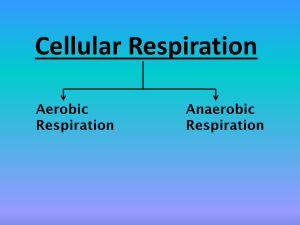Clothespin Lab / Muscle Fatigue
advertisement
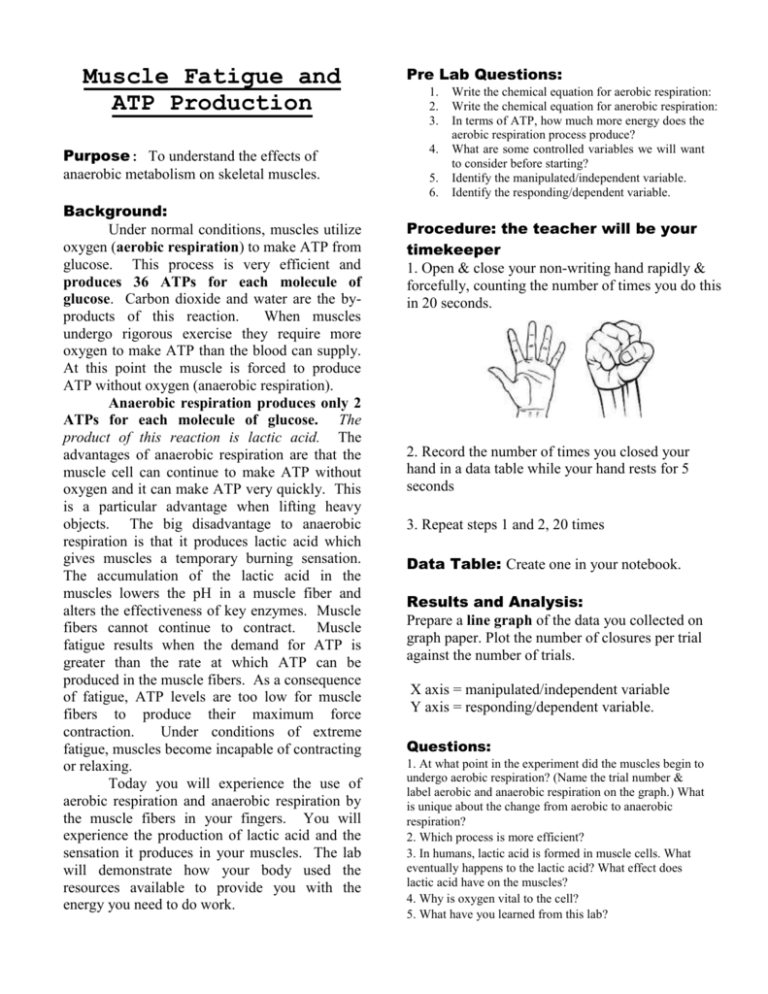
Muscle Fatigue and ATP Production Purpose: To understand the effects of anaerobic metabolism on skeletal muscles. Background: Under normal conditions, muscles utilize oxygen (aerobic respiration) to make ATP from glucose. This process is very efficient and produces 36 ATPs for each molecule of glucose. Carbon dioxide and water are the byproducts of this reaction. When muscles undergo rigorous exercise they require more oxygen to make ATP than the blood can supply. At this point the muscle is forced to produce ATP without oxygen (anaerobic respiration). Anaerobic respiration produces only 2 ATPs for each molecule of glucose. The product of this reaction is lactic acid. The advantages of anaerobic respiration are that the muscle cell can continue to make ATP without oxygen and it can make ATP very quickly. This is a particular advantage when lifting heavy objects. The big disadvantage to anaerobic respiration is that it produces lactic acid which gives muscles a temporary burning sensation. The accumulation of the lactic acid in the muscles lowers the pH in a muscle fiber and alters the effectiveness of key enzymes. Muscle fibers cannot continue to contract. Muscle fatigue results when the demand for ATP is greater than the rate at which ATP can be produced in the muscle fibers. As a consequence of fatigue, ATP levels are too low for muscle fibers to produce their maximum force contraction. Under conditions of extreme fatigue, muscles become incapable of contracting or relaxing. Today you will experience the use of aerobic respiration and anaerobic respiration by the muscle fibers in your fingers. You will experience the production of lactic acid and the sensation it produces in your muscles. The lab will demonstrate how your body used the resources available to provide you with the energy you need to do work. Pre Lab Questions: 1. 2. 3. 4. 5. 6. Write the chemical equation for aerobic respiration: Write the chemical equation for anerobic respiration: In terms of ATP, how much more energy does the aerobic respiration process produce? What are some controlled variables we will want to consider before starting? Identify the manipulated/independent variable. Identify the responding/dependent variable. Procedure: the teacher will be your timekeeper 1. Open & close your non-writing hand rapidly & forcefully, counting the number of times you do this in 20 seconds. 2. Record the number of times you closed your hand in a data table while your hand rests for 5 seconds 3. Repeat steps 1 and 2, 20 times Data Table: Create one in your notebook. Results and Analysis: Prepare a line graph of the data you collected on graph paper. Plot the number of closures per trial against the number of trials. X axis = manipulated/independent variable Y axis = responding/dependent variable. Questions: 1. At what point in the experiment did the muscles begin to undergo aerobic respiration? (Name the trial number & label aerobic and anaerobic respiration on the graph.) What is unique about the change from aerobic to anaerobic respiration? 2. Which process is more efficient? 3. In humans, lactic acid is formed in muscle cells. What eventually happens to the lactic acid? What effect does lactic acid have on the muscles? 4. Why is oxygen vital to the cell? 5. What have you learned from this lab? Muscle Fatigue & ATP Production Muscle Fatigue & ATP Production Pre Lab Questions: 1. Write the chemical equation for aerobic respiration: 2. Write the chemical equation for anerobic respiration: 3. In terms of ATP, how much more energy does the aerobic respiration process produce? 4. What are some controlled variables we will want to consider before starting? 5. Identify the manipulated/independent variable: 6. Identify the responding/dependent variable: Pre Lab Questions: 1. Write the chemical equation for aerobic respiration: 2. Write the chemical equation for anerobic respiration: 3. In terms of ATP, how much more energy does the aerobic respiration process produce? 4. What are some controlled variables we will want to consider before starting? 5. Identify the manipulated/independent variable: 6. Identify the responding/dependent variable: Questions: 1. At what point in the experiment did the muscles begin to undergo aerobic respiration? (Name the trial number & label aerobic and anaerobic respiration on the graph.) What is unique about the change from aerobic to anaerobic respiration? 2. Which process is more efficient? 3. In humans, lactic acid is formed in muscle cells. What eventually happens to the lactic acid? What effect does lactic acid have on the muscles? 4. Why is oxygen vital to the cell? 5. What have you learned from this lab? Questions: 1. At what point in the experiment did the muscles begin to undergo aerobic respiration? (Name the trial number & label aerobic and anaerobic respiration on the graph.) What is unique about the change from aerobic to anaerobic respiration? 2. Which process is more efficient? 3. In humans, lactic acid is formed in muscle cells. What eventually happens to the lactic acid? What effect does lactic acid have on the muscles? 4. Why is oxygen vital to the cell? 5. What have you learned from this lab? Muscle Fatigue & ATP Production Pre Lab Questions: 1. Write the chemical equation for aerobic respiration: 2. Write the chemical equation for anerobic respiration: 3. In terms of ATP, how much more energy does the aerobic respiration process produce? 4. What are some controlled variables we will want to consider before starting? 5. Identify the manipulated/independent variable: 6. Identify the responding/dependent variable: Questions: 1. At what point in the experiment did the muscles begin to undergo aerobic respiration? (Name the trial number & label aerobic and anaerobic respiration on the graph.) What is unique about the change from aerobic to anaerobic respiration? 2. Which process is more efficient? 3. In humans, lactic acid is formed in muscle cells. What eventually happens to the lactic acid? What effect does lactic acid have on the muscles? 4. Why is oxygen vital to the cell? 5. What have you learned from this lab? Muscle Fatigue & ATP Production Pre Lab Questions: 1. Write the chemical equation for aerobic respiration: 2. Write the chemical equation for anerobic respiration: 3. In terms of ATP, how much more energy does the aerobic respiration process produce? 4. What are some controlled variables we will want to consider before starting? 5. Identify the manipulated/independent variable: 6. Identify the responding/dependent variable: Questions: 1. At what point in the experiment did the muscles begin to undergo aerobic respiration? (Name the trial number & label aerobic and anaerobic respiration on the graph.) What is unique about the change from aerobic to anaerobic respiration? 2. Which process is more efficient? 3. In humans, lactic acid is formed in muscle cells. What eventually happens to the lactic acid? What effect does lactic acid have on the muscles? 4. Why is oxygen vital to the cell? 5. What have you learned from this lab?


